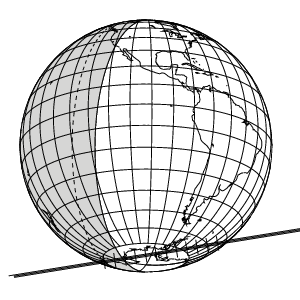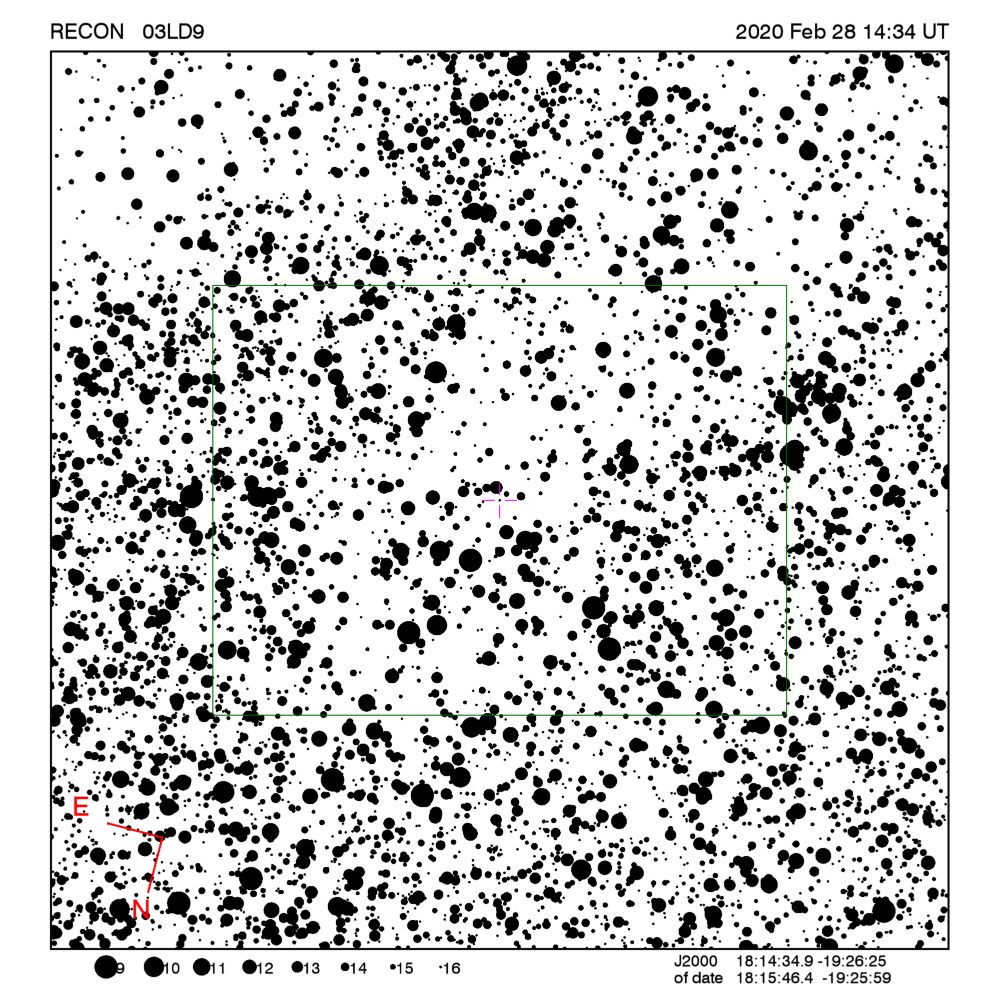RECON: TNO occultation with 03LD9
Event between 03LD9 and star GA0700:21455782
with event index number of 1661865
Geocentric closest approach at 2020/02/28 14:33:51 UTC
J2000 position of star is 18:14:34.9 -19:26:25
Equinox of date position of star is 18:15:45.5 -19:25:59
Stellar brightness G=16.5,
use SENSEUP=128
Star is 120 degrees from the moon.
Moon is 21% illuminated.
TNO apparent brightness V=23.1
 TNO is 42.7 AU from the Sun
and 43.1 AU from the Earth.
TNO is 42.7 AU from the Sun
and 43.1 AU from the Earth.
The TNO is moving 17.6
km/sec on the sky relative to the star, or,
2.0 arcsec/hr.
The 1-sigma error in the time of the event is 777 seconds.
The 1-sigma cross-track error in the shadow position is
2268 km.
The TNO has an absolute magnitude Hv=6.6
Diameter=295.1 km assuming a 5% albedo -- 16.8 sec chord
Diameter=120.5 km assuming a 30% albedo -- 6.9 sec chord
Dynamical classification is SCATNEAR
Star training set for 03LD9, (2020/02/28 14:34UT)
Object RA Dec mag sep mel
Antares 16:30:38.8 -26:28:30 0.9 25.15 143
Nunki 18:56:30.8 -26:16:12 2.0 11.60 111
PPM 234244 18:16:41.9 -18:39:13 6.1 0.81 120
PPM 234237 18:16:28.0 -18:59:06 7.6 0.48 120
PPM 234227 18:15:58.3 -19:29:09 9.0 0.07 120
03LD9 18:15:46.4 -19:25:59 16.5 120
Positions are for equinox of date

Azimuth is measured in degrees eastward from north.
North is at an azimuth of 0, due East is at an azimuth
of 90 degrees, due South is 180, and due West is 270.
Do not use the listing below for the RECON CPC 1100 telescopes.
This is provided for other non-team facilities.
Star training set for 03LD9, (2020/02/28 14:34UT)
Object RA Dec mag sep mel
Antares 16:29:24.4 -26:25:56 0.9 25.15 143
Nunki 18:55:15.9 -26:17:49 2.0 11.60 111
PPM 234244 18:15:30.8 -18:39:42 6.1 0.81 120
PPM 234237 18:15:16.8 -18:59:34 7.6 0.48 120
PPM 234227 18:14:46.7 -19:29:36 9.0 0.07 120
03LD9 18:14:34.9 -19:26:25 16.5 120
Positions are for J2000
Event circumstances last updated at 2019/12/01 22:49:51 UT
Marc W. Buie,
Southwest Research Institute
RECON
 TNO is 42.7 AU from the Sun
and 43.1 AU from the Earth.
TNO is 42.7 AU from the Sun
and 43.1 AU from the Earth.
